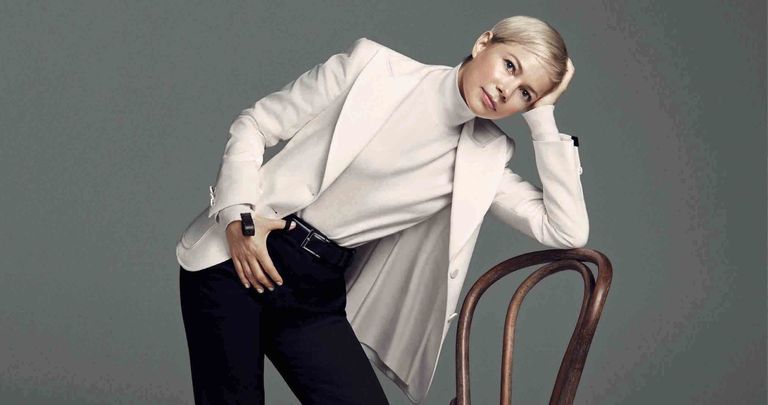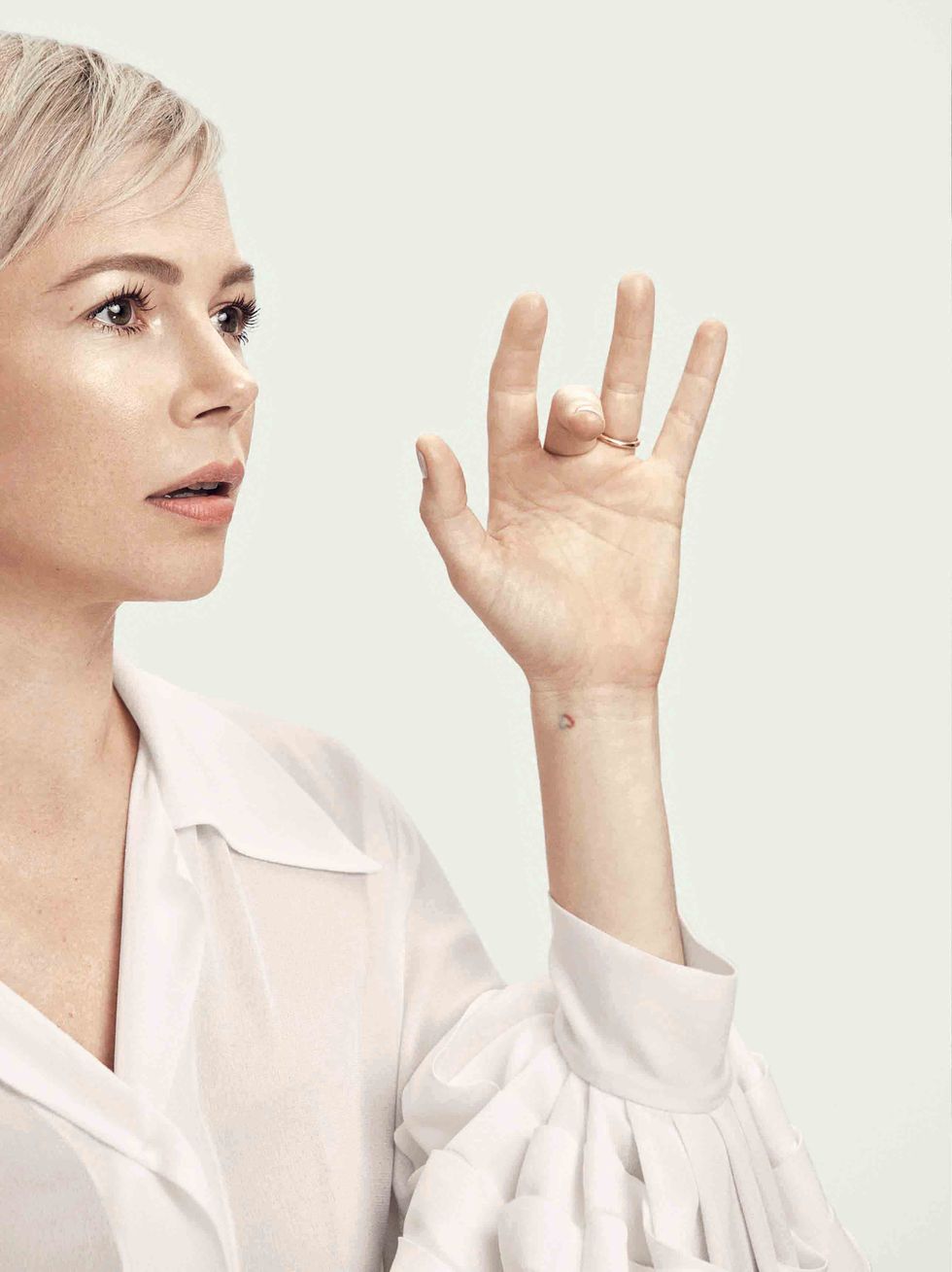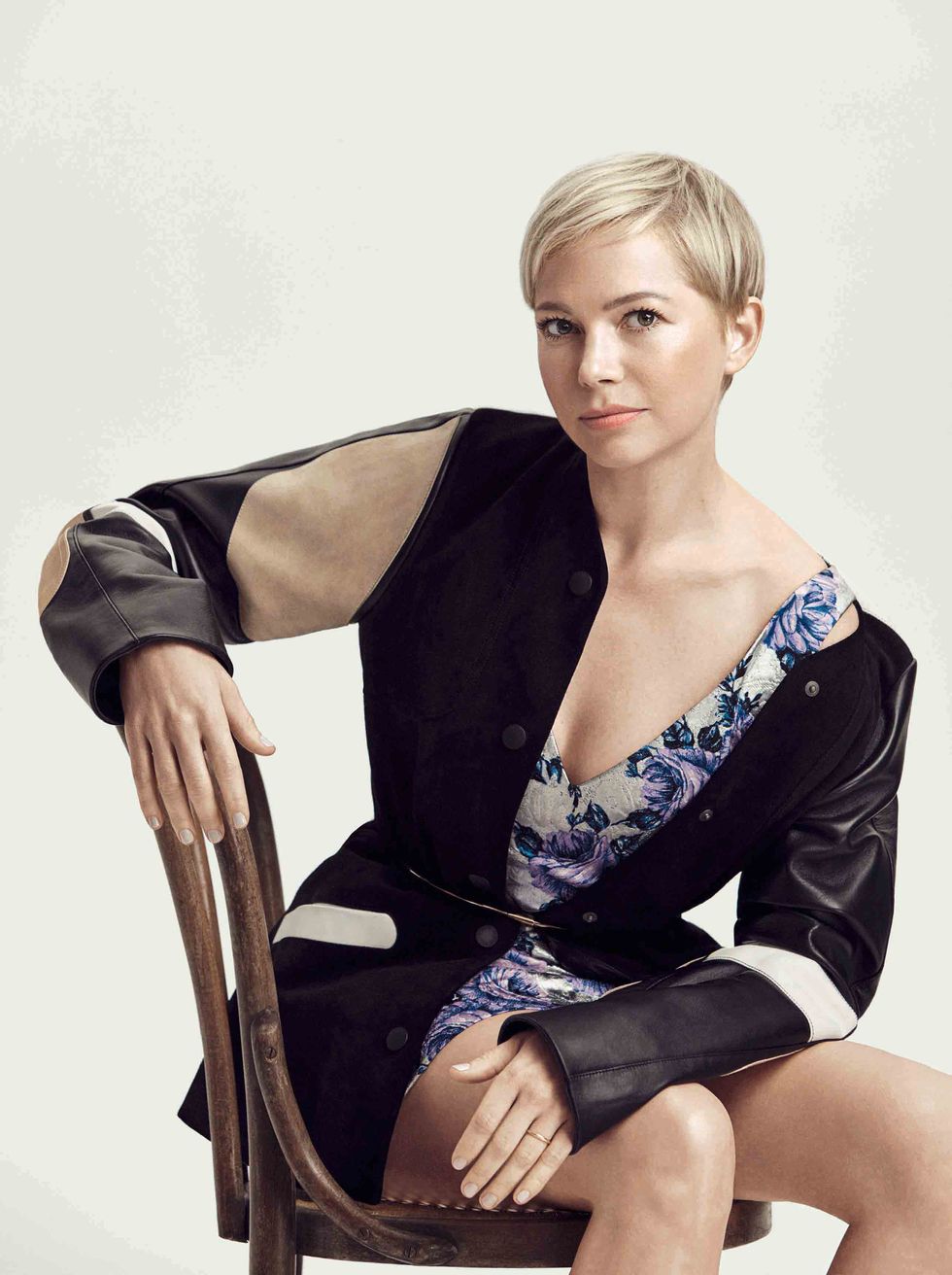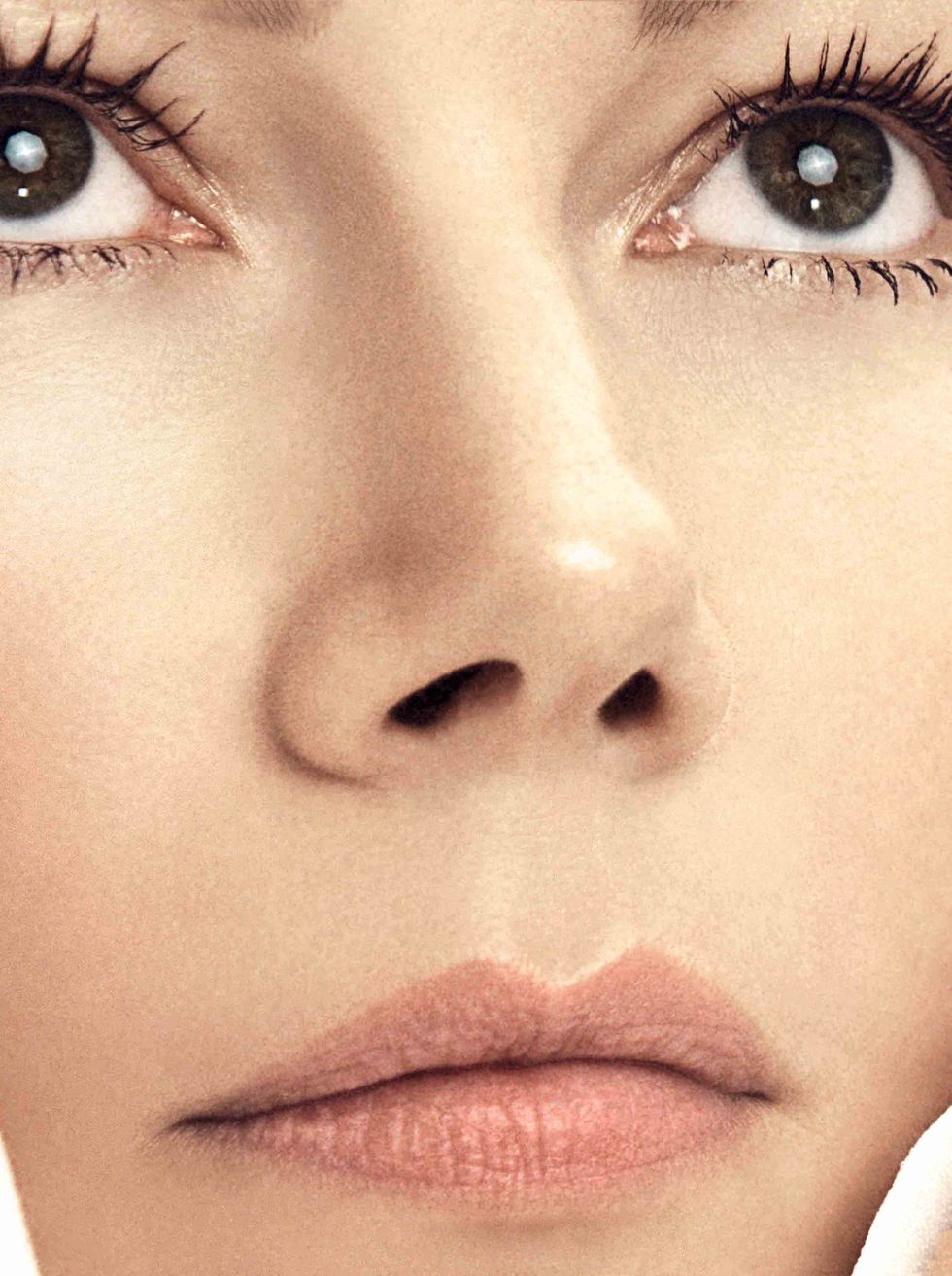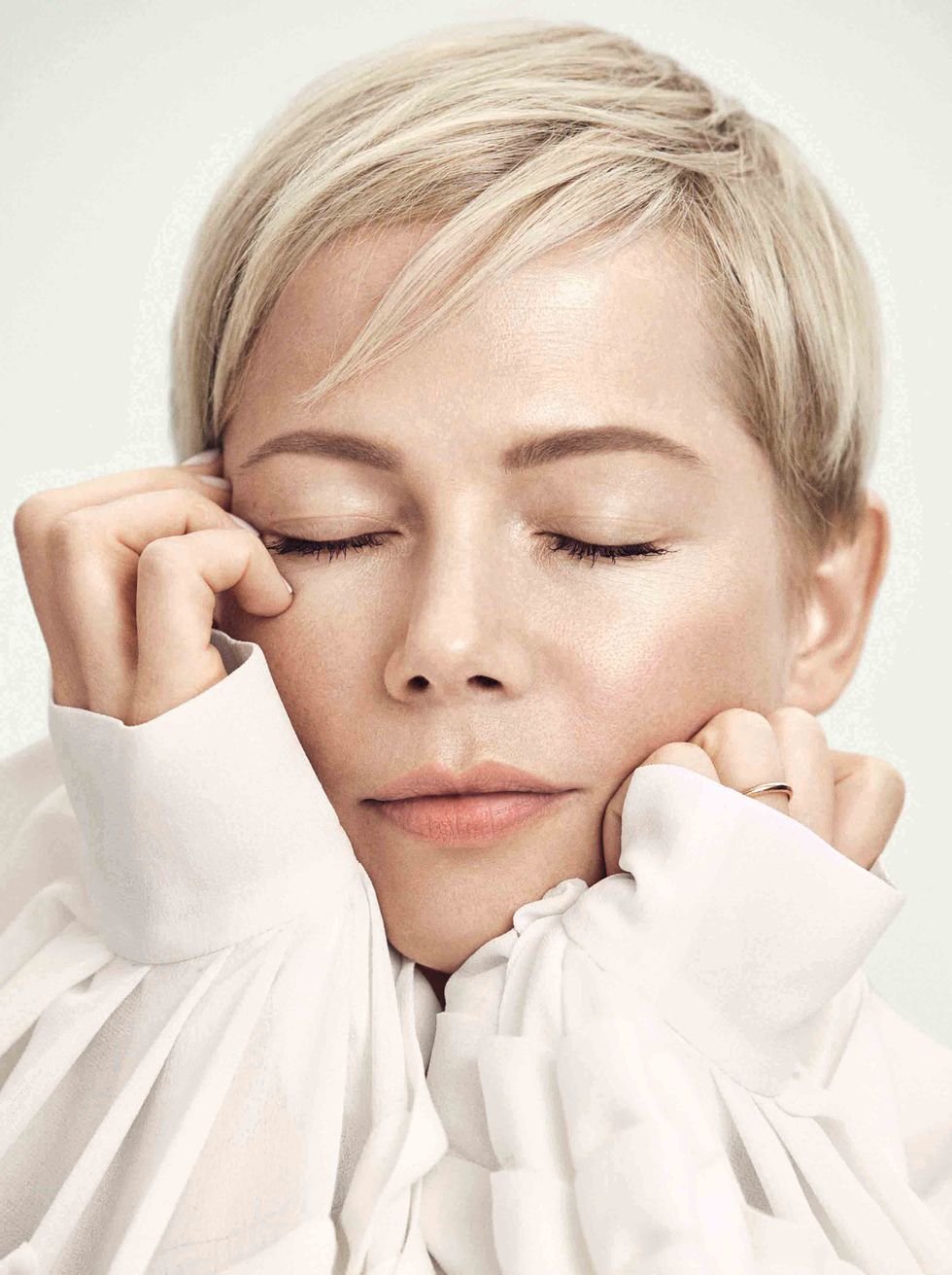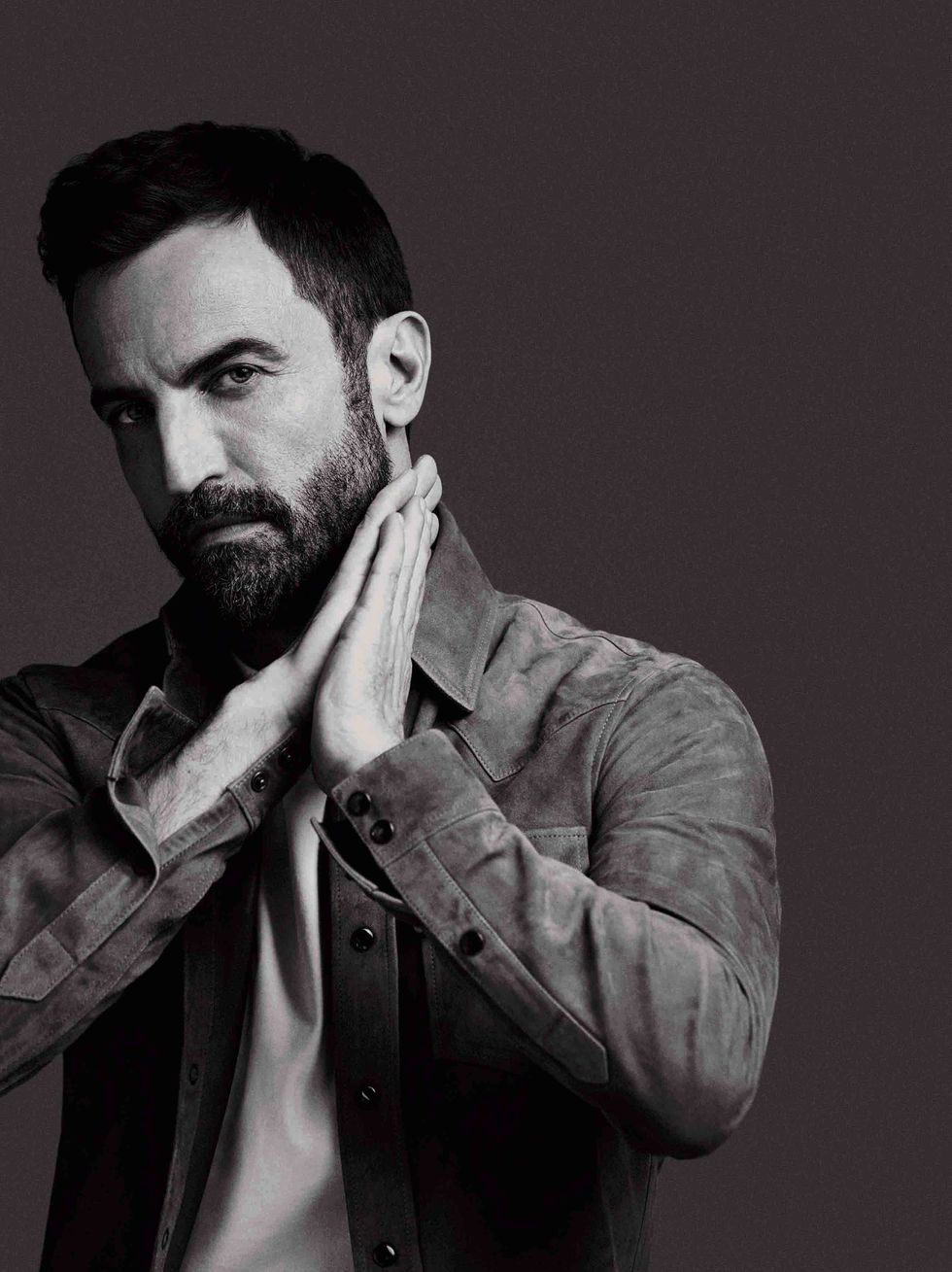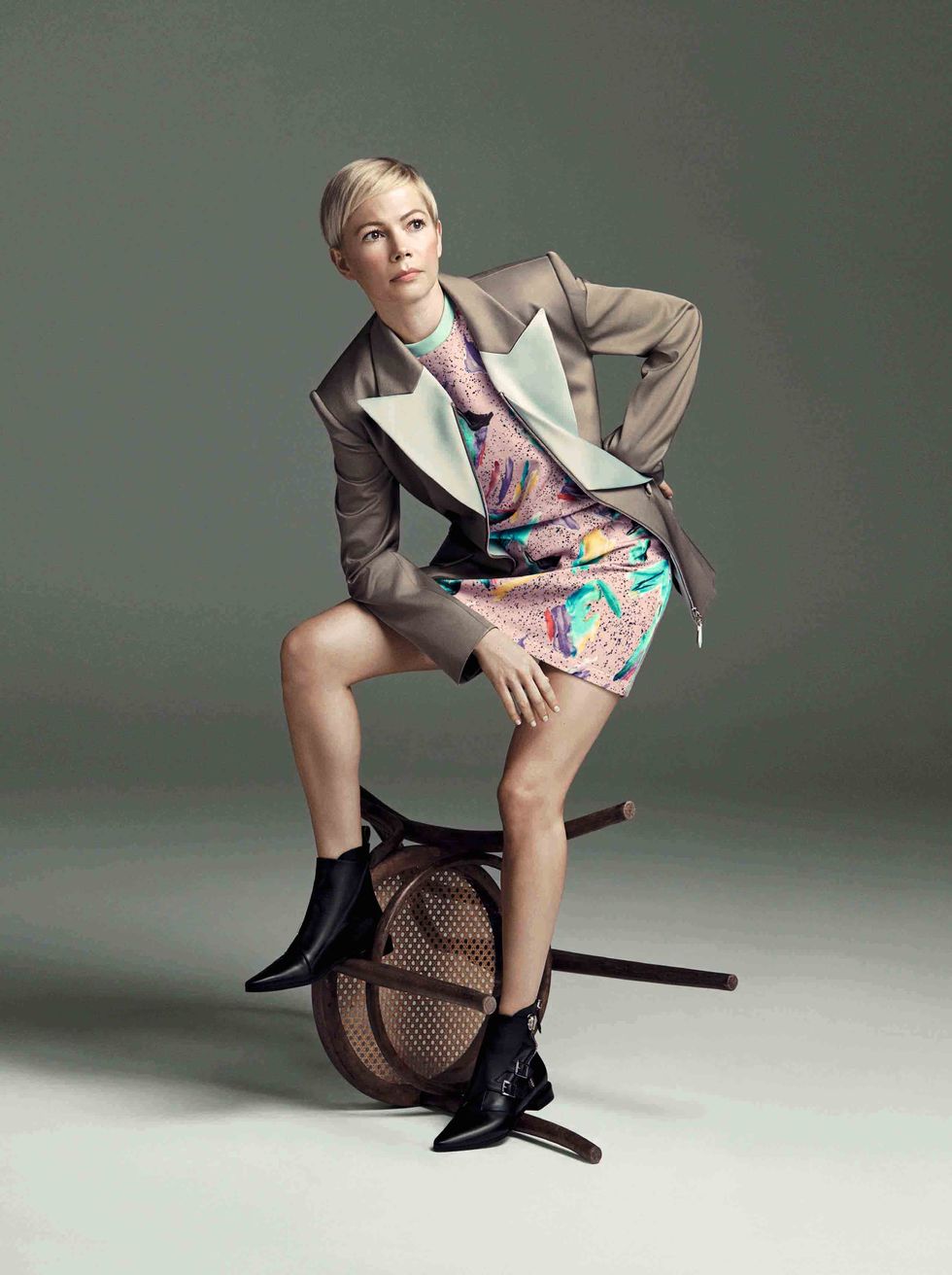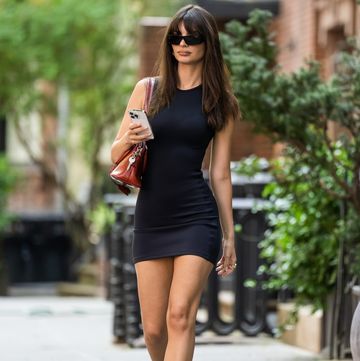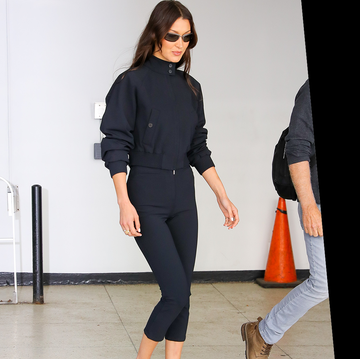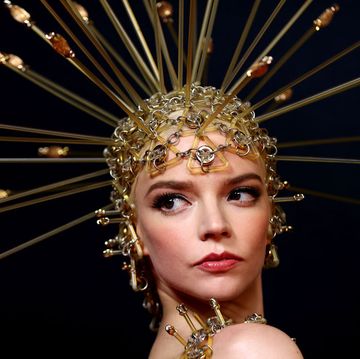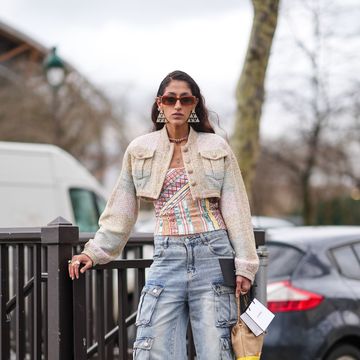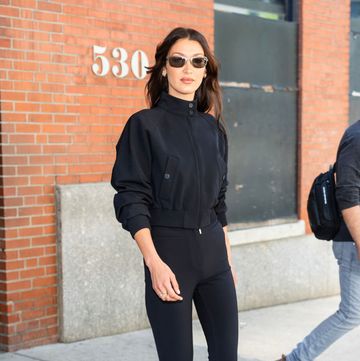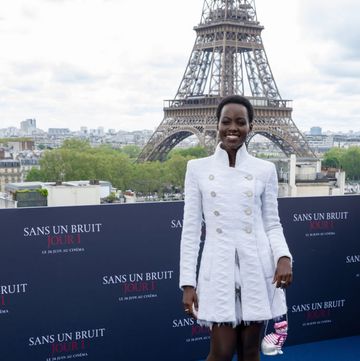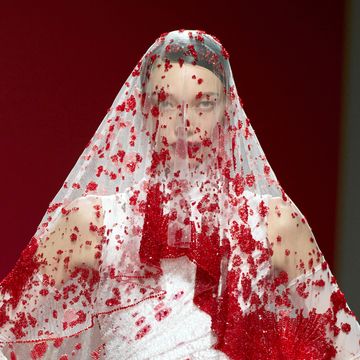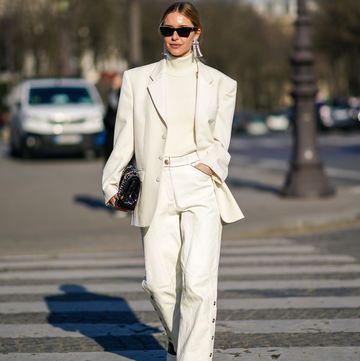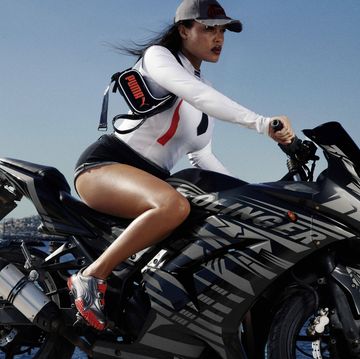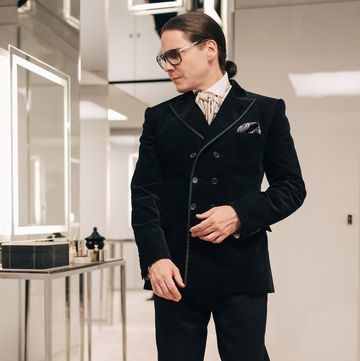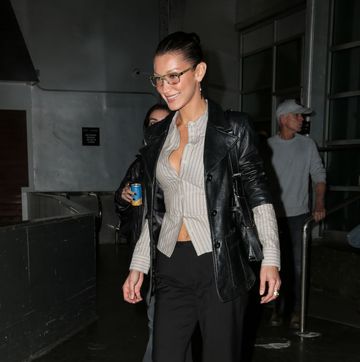Photos by Mariana Maltoni. Styling by Anne-Marie Curtis. Clothes by Louis Vuitton
Michelle Williams Doesn't Do Instagram...
It’s not that she looks down on it – after all, her best mate, the actress Busy Philipps, is such a bravura expert at filming off-the-cuff Instagram Stories that she parlayed her 1.5 million followers into a book deal and a new late-night talk show on E! – it’s that Williams just isn’t very good at it.
‘I haven’t figured out how to use [social media] as a source for my own good,’ she says. ‘I haven’t figured out how to use it to find something inspiring or beautiful.’ Instead, she relies on Philipps to text her the important news of the day so she can stay in the loop.
We are sitting together early on a crisp autumn morning in New York City, sandwiched into a corner banquette inside the low-lit back room of the Marlton Hotel in Greenwich Village.
Williams is nursing a cappuccino and wearing simple tailored high-waisted black trousers and a striped boat-neck jumper; with her short pixie cut, she looks a bit Marcel Marceau meets Audrey Hepburn. She chose this spot for us to meet because she loves its history (built in 1900, the hotel was once a hotspot for urban bohemians Edna St Vincent Millay and Jack Kerouac).
‘I’m just not a techy person,’ she continues. ‘I grew up on Ralph Waldo Emerson, Walt Whitman and Henry David Thoreau. They meant so much to me; they planted seeds and they’re sort of still there. Those seeds don’t really grow on the internet.’
She pauses, grins and wrinkles her nose, realising she has just (quite passionately) compared not having a Twitter account to living like Henry David Thoreau, alone in a log cabin. ‘It’s a little ridiculous to be so unknowledgeable about the thing that has sort of taken over the world,’ she says with a sigh. ‘I guess I don’t relate to it, which probably makes me irrelevant.’
It doesn’t. In fact, after an hour of sharing a pistachio vinyl booth and hearing about her unplugged life philosophy, I’m tempted to throw my digital devices into the Hudson River. In a world of noise and information overload, Williams has chosen to hold something back – she may just be one of the last actors in Hollywood to maintain an aura of total mystery.
Now 38, Williams is a working mother of a teenager (Matilda, her daughter with late partner Heath Ledger, is now 13 years old). She is currently acting in her first television role, as legendary Broadway dancer Gwen Verdon – who was married to renowned choreographer Bob Fosse, played by Sam Rockwell – in FX’s Fosse/Verdon.
The show, which is being executive-produced by creator of Hamilton Lin-Manuel Miranda, has proven to be an intense grind, requiring hours of daily rehearsal at New York performing arts school Juilliard. Right after we meet, Williams tells me, she is going to grab the ‘giant dance bag’ from her car and head to a Midtown studio, where she will change into tights (and maybe even a bowler hat) and shimmy around to Mambo beats while holding her elbows at a precise right angle.
Williams’ fascination with leaping into others’ lives began when she was around ten years old, when she ‘dressed up as an old lady’ one year for Halloween. Her family (including her father, a commodities trader, and mother, a homemaker, who have since divorced) had recently moved from rural Kalispell, Montana, where she grew up learning to fish along alpine trails, to the sun-baked seaside town of San Diego, California, and she was still adjusting to her new surroundings.
Playing dress-up made her feel powerful and able to cope with change. ‘The idea of becoming someone else through an internal and external process hooked me at an early age,’ says Williams. ‘What does it feel like to put on the costume of somebody else? How do these clothes change me, how does this wig change me, how does this walk change me? As I’ve gotten older, that’s been the work I’ve been most interested in – that transformation, instead of repletion or endless self-replication.’
After performing in local theatrical productions, Williams convinced her parents to shuttle her to Los Angeles for bigger auditions. She landed her first television role at 13 in an episode of Baywatch (she had to run down a beach in a floral bikini, which she has not done on camera since). By 15, she had appeared in several more TV shows and films and relocated to Los Angeles permanently, finishing high school by mail.
At 17, she was cast as the brooding, rebellious Jen Lindley in a new teenage soap opera called Dawson’s Creek. Of course, she had no idea that the show would become the international phenomenon it did – or bring the kind of sudden stardom that most young actors only dream about; the kind where your face appears in bedroom posters of teenagers across the world.
Some actors who experience that kind of success so early keep trying to chase it throughout their lives, but Williams had a different reaction. She understood its value – the regular paycheck gave her freedom – but mostly she understood the limitations of being that kind of celebrity.
Instead, she decided what she wanted was to do work that challenged her; that pushed her into new corners of empathy. Williams found this type of work when she moved to New York City at 19 to star in an off-Broadway play called Killer Joe. She has never felt the need to live in LA since. ‘I like my friends there, but that’s kind of where it ends,’ she says. ‘Even the weather I can do without, that eternal sunshine.’
Over the past two decades, she has consistently selected roles that push her into new terrain. In 2005, she played Alma Beers del Mar, the ruddy, long-suffering wife of a closeted gay man in Brokeback Mountain opposite Ledger, who she began dating on set (she earned an Oscar nomination for the role, appearing on the red carpet in a gorgeous, now-iconic mustard-yellow Vera Wang gown).
Williams then swerved from that hyper-realistic role into the absurdist world of writer and director Charlie Kaufman in Synechdoche, New York, and then into a series of heart-wrenching films with the indie director Kelly Reichard. She worked with the legendary Martin Scorsese on Shutter Island, and played a jilted lover opposite Ryan Gosling in Blue Valentine. In 2011, she veered again, taking on the glamorous task of emulating Marilyn Monroe in My Week with Marilyn.
Of all her roles, Williams tells me, she may cherish her time as Sally Bowles in a revival of the musical Cabaret the most. She still keeps the shoes she wore on stage – shoes she wore for eight shows a week for almost a year – next to her fireplace in her Brooklyn home. ‘They’re my prized possession,’ she says. ‘If my house were on fire and I could only get one object, I’m taking those grimy shoes.’
Williams says theatre was where she really learned how to be present in her work. Of doing a live show, she says: ‘You can have a real understanding of how you did – if you were on it or off it; if you caught the wave or you didn’t. And you can do it again the next night and sort of tinker with it. You get to continually refine your experience of the performance, which affects the audience’s experience, and that energetic transmission between the two is what’s so satisfying. In fact, it’s the thing I like about being a parent; it’s the thing that all humans like about being in human relationships.’
This reflective approach to work is something she shares with Nicolas Ghesquière, artistic director of Louis Vuitton. Her relationship with the fashion house is long-standing, and it’s the perfect fit: the intelligent, otherworldliness of Ghesquière’s creations chiming with her personality.
Williams seems to understand that in order for her to give everything away on camera, she needs to maintain a healthy distance from the rest of the world. A lot of this knowledge has come with age: ‘My 20s felt like, “Who am I? What am I going to make of all this time on the planet? What do I want? What is happiness? Who are my friends? What’s wrong with me? How do I fix it? Who am I?”’
Yet today, her mindset couldn’t be more different. She got married last year to Phil Elverum, lead singer of the band Mount Eerie. She’s moved house (well, within her beloved Brooklyn), and she’s working more than ever. She is even appearing in blockbusters – last year, she starred in Marvel popcorn flick Venom, and also played her first daffy comedic role, as an ice queen magazine editrix in I Feel Pretty.
In the era of the #MeToo movement, she is also embracing her role as an influential woman working in Hollywood, whose actions might be an example to others.
In 2017, after abuse allegations against Kevin Spacey led to his removal from the film All the Money in the World, the studio asked Williams and her co-star Mark Wahlberg to return to set to reshoot some scenes. Michelle Williams took $1,OOO for her labour, assuming Wahlberg had received the same fee. When she discovered the studio paid him a whopping $1.5 million for the same job, she spoke out publicly about the discrepancy.
‘I do feel a responsibility,’ she says. ‘It’s been really heartening and rewarding for me to hear from other women; how they heard what I went through and how it gives them an example [of how] to ask for reparation, and to be able to institute that tiny little model in other scenarios. That has been really one of the most rewarding things not just of my career, but of my life.’ She continues: ‘Also, to have things flipped. Because I went from feeling very helpless, and now I feel helpful.’
Nevertheless, Williams still doesn’t think of herself as a ‘powerful’ person. ‘“Power” is such a funny word; I never really felt connected to it,’ she says. ‘I think it’s because when I had seen examples of it in my life, it was misused. Power was never something I wanted in the way I had seen it represented. So I think a kind of redefinition of power, what that might mean personally for me, has taken place. I guess I could call it power, or just the ability to support my family in a meaningful way. The ability to ensure that the workplace is safe and fair; the ability to make choices not from a place of fear.’
Williams is now making all her career choices, she says, from a place of joy and daring. She has signed on to play Janis Joplin in a new biopic, a role that she has wanted to do ‘so badly’ for years. ‘[Joplin] was so prophetic, and so young, and what was coming out of her mouth was ahead of her time,’ she says. ‘It’s a voice that should be re-revealed. She gender-bended.
People love it when the androgyny is a man becoming a woman, but don’t have the same sort of reverence or desire for it when it’s a woman embodying her masculine side. I’d like to go into that.’
She is also attached to a film in which she will play an abortion activist in Sixties Chicago. ‘It feels like something I wouldn’t have been able to do five or ten years ago. It feels like pressure I wouldn’t have been able to handle; the largeness of it.’
Williams tries to offset it all – the weighty women’s stories, splashy television series, embodying rock icons – by allowing herself quietness when she’s off set. This year, she will appear opposite Billy Crudup and Julianne Moore in After the Wedding, a film about a woman who runs an orphanage in India, who must travel to New York to meet a benefactor. While filming in India she became obsessed with the Upanishads, a series of ancient Sanskrit texts. ‘I was really into it. “Relent and enjoy” is what Ghandi said – that was his summation. Wait, no. It was “renounce and enjoy”.’
I ask what she feels she is supposed to renounce. She stops for a moment, sips her coffee, then answers with a single word: ‘Attachment.’ This, it seems, is life for Williams. She attaches herself completely to a role, letting it absorb and envelop her. And then, just like that, she lets it go.
Last October, Nicolas Ghesquière Lit Up The Louvre - Literally
For his late-night SS19 Louis Vuitton show, he commissioned set designer Es Devlin to construct a luminous, space-age tubular structure that made the cobblestone Cour Carée feel like the inside of a spaceship. The effect was futuristic, but also strangely unmoored from time. It was like watching a show through a dream, or a void.
The clothes shared the same fluidity: of the present and the past at once, with Eighties throwbacks alongside high-tech fabrics, space-suit sleeves and Memphis prints. Take the first look that Ghesquière sent out: Dominican model Ambar Cristal Zarzuela wearing a billowing blouson jacket in turquoise and tan with a pair of prim patent leather lace-up booties. It was part Mad Max heroine, part Victorian schoolgirl crossed with a Star Wars fighter pilot. It was 19OO, 198O and 2O8O all at the same time, seamlessly blended into the upside-down triangle silhouette that has become Ghesquière’s signature.
‘It’s about a world where imagination is endless,’ he explains, sporting a navy plaid shirt, short beard and playful grin when I meet with him a few months later at New York’s Milk Studios, where he’s being photographed with his friend and muse Michelle Williams for ELLE. According to Ghesquière, he references science fiction in his designs not because he sees it as an escapist fantasy, but as a ‘sooner present’: the aesthetics of a world that is almost already here. ‘I was always interested in anticipation,’ he explains. ‘In every way – in movies and comics and different expressions that exist to look forward.’
It’s a fitting expression of what has become Ghesquière’s USP. For the past 20 years – first at Balenciaga and now at Vuitton – he has established himself as a visionary of understated, almost translucent glamour. He’s been at Vuitton for five years now, and he’s relaxing into the role, embracing playful imagery and the pop-cultural references from his youth (his Instagram is currently a vivacious mixture of Star Wars memorabilia, heavy-metal T-shirts and his two black Labradors).
Scratch the surface deeper and you realise one of the keys to Ghesquière’s success is that he obsesses. He grabs on to images, ideas or shapes and can’t let them go. When he was growing up in the village of Loudon, western France, he plastered his bedroom walls with posters of his heroes, including Wonder Woman – his favourite Marvel heroine. ‘You know that adolescent room, when you put your obsession on the walls,’ he says. ‘It’s like that bedroom never disappeared in my head.’
Just as a teenager’s bedroom walls are a mélange of their voracious passions, so Ghesquière’s collections are a seamlessly stitched-together mood board. It’s a process he calls ‘a proper life collage’, which he compares to inventing new dishes in a kitchen where the pantry is always stocked with his idiosyncratic interests: ‘Always a different meal, but with exactly the same ingredients,’ he says. In less-skilled hands, his science-fiction references could skew kitsch, but Ghesquière avoids this, making his work seem less like costumes and more like ‘a suit of armour’. He considers his last show to have been an homage to women’s bravery. He tells me he wants women to feel bold while wearing his designs: ‘I look up to women as heroines – in my childhood, and later, and still now. So there is that intention to bring powers. Superpowers.’
His Louis Vuitton front rows are testament to this, lined as they are by smart, accomplished women from across the generational spectrum: Jennifer Connelly, Catherine Deneuve, Alicia Vikander and, of course, Michelle Williams. He considers Williams, who has been a Vuitton ambassador for more than five years, to be the modern-day equivalent of the superheroines he pinned on his bedroom wall as a boy. ‘When I joined Vuitton, I was so pleased by the fact that I was going to meet her and work with her. The way she welcomed me was so warm.’
For Ghesquière, the wearer is key. His clothes enhance and embolden, never eclipse: ‘I first design from instinct, an intuition I want to express something. So I draw, then at some point [I start] questioning if Michelle, for example, would love this look. I’m thinking, “OK, I guess this is something that can speak to her.”’ It’s a sentiment that was fostered early; growing up the son of a golf-course manager father and fashion-loving mother, he was ‘attracted to be curious about fabrics and how to build a silhouette, and how this silhouette would belong to someone’.
Ghesquière credits Jean Paul Gaultier (who he assisted in the early Nineties) with teaching him to ‘not be afraid to destroy something in order to build something new’. This thirst for innovation made him an ideal fit for Balenciaga, where he was creative director from 1997 until 2O12 and introduced the top-heavy silhouette that went on to dominate the Noughties (slender trousers, voluminous blouses, cocoon-sleeve sweatshirts). His appointment, aged just 25, came as a surprise to the industry. But it proved the perfect fit: the French house was starting to feel dusty, and Ghesquière’s precision and playfulness mirrored that of Cristóbal Balenciaga. In one season, the young designer revived interest in a brand that the industry had long considered on life support.
When Ghesquière landed at Vuitton in 2013, many wondered what he would do with a luxury brand whose history as a luggage company has made travelling and adventure part of its DNA. But Ghesquière, who is only the second women’s apparel designer to helm the LV brand (the first was Marc Jacobs), took this design prompt and made it his own. He has infused Vuitton with his trademark formalism, but has also allowed his mind to roam like a globetrotter – and beyond, exploring other universes, as for SS19. ‘It’s not casual,’ he says of Vuitton’s aesthetic. ‘But there is this idea that it shouldn’t be too stiff. You have to think about how people can really move in it and live in it.’
He is starting to look towards his own future now – his own ‘sooner present’. One day he may start his own namesake label. But for now, Ghesquière is very happy where he is. He is a monogamist when it comes to fashion: staying at houses long-term, allowing himself to grow. He likes time to evolve, to ruminate, to let his obsessions simmer. ‘I am a slow thinker,’ he says. ‘I usually need time to process. I want to create a desire, something that people love.’
